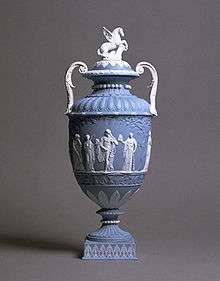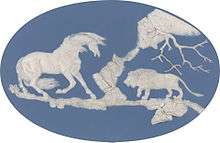Jasperware

Jasperware, or jasper ware, is a type of pottery first developed by Josiah Wedgwood in the 1770s. Usually described as stoneware, some authorities have described it as a type of porcelain.[2] It is noted for its matte and unglazed biscuit finish and is produced in a number of different colours, of which the best known is a pale blue that has become known as Wedgwood Blue.[3] Relief decorations (typically in white but also in other colours)[4] are characteristic of Wedgwood jasperware. They are produced in moulds and applied to the ware as sprigs.
Jasperware composition and colours

While named after the mineral jasper, modern analyses indicate that barium sulphate is a key ingredient.[5] Wedgwood had introduced a different type of stoneware called black basalt a decade earlier.
Jasperware's composition varies but proportions may be given as follows: sulphate of barytes 150, china clay 35, blue clay 45, flint 35, gypsum 6, and Cornish stone 50.[6] It is white by nature but stained with metallic oxide colors; its most common shade in commerce is pale blue, but dark blue, lilac, sage green, black, and yellow are also used, with sage green due to chromium oxide, blue to cobalt oxide, and lilac to manganese oxide, with yellow probably coming from a salt of antimony, and black from iron oxide.[7] The earliest jasper was stained throughout and was known as "solid," but by 1829 production in jasper had virtually ceased. In 1844 production resumed using items coloured only on the surface and known as "dip." Solid jasper was not manufactured again until 1860.[8]
Wedgwood designs
Jasperware is particularly associated with the neoclassical sculptor and designer John Flaxman Jr who began to supply Wedgwood with designs from 1775. Flaxman mostly worked in wax when designing for Wedgwood.[9] The designs were then cast: some of them are still in production.
Sir William Hamilton's collection of ancient Greek vases was an important influence on Flaxman's work. These vases were first known in England from D'Hancarville's engravings, published from 1766.[9] Inspiration for Flaxman and Wedgwood came not only from ancient ceramics, but also from cameo glass, particularly the Portland Vase which was brought to England by Sir William Hamilton. The vase was lent to Wedgwood by the third Duke of Portland. Wedgwood devoted four years of painstaking trials at duplicating the vase - not in glass but in black and white jasperware.
-

Horse Frightened by a Lion, plaque, 10 x 16 inches, 1780, after George Stubbs
-

Jasperware button[1]
-

Belt clasp designed by Lady Templeton and Miss Crew for Josiah Wedgwood's factory. Jasperware, steel, tin. The Walters Art Museum
-
.jpg)
A Wedgwood jardiniere
Date markings
Wedgwood jasperware can often be dated by the style of potter's marks, although there are exceptions to the rules:
- Before 1860: Mark is "Wedgwood". Usually accompanied by other potter markings and a single letter.
- From 1860-1929: A three-letter mark represents in order, the month, the potter, and the year. The year code starts mid-alphabet with the letter "O" for 1860, the letter "P" for 1861, etc., returning to "A" after "Z". For certain letters there are two possible year dates. Unfortunately these date codes were used quite infrequently on jasperware pieces. A single letter is more commonly found during this time period but it is merely a potter's mark and of no consequence for dating the object.[10]
- 1891-1908: Marks are "Wedgwood", "England", separated.
- 1908-1969: Marks are "Wedgwood", "Made in England", separated, or "Wedgwood England" on small objects like thimbles. After 1929 the typeface of the word "Wedgwood" is changed to sans serif.
- 1970–present: Mark is "Wedgwood Made in England" as single stamp
Other jasperware
Jean-Baptiste Stahl developed his own style and techniques during his work at Villeroy & Boch in Mettlach, Saar, Germany. The name Phanolith was coined for this kind of jasperware. His work is praised for the translucency of the white porcelain on a colored background. JBS's work is known for its refined modelling and the vibrancy of its figures. He thus combined the benefits of jasperware and pâte-sur-pâte. A stand at the World's Fair 1900 in Paris was the first major public presentation of his work and gained him a gold medal. For this event, two huge wall plates were created with dimensions of 220 cm x 60 cm, each.
-

Phanolith plaque at the height of his work.
-

Full signature JStahl.
Spain
The Real Fabrica del Buen Retiro in Madrid produced jasperware. At the end of the eighteenth century jasperware plaques were used in the decoration of the Casita del Príncipe.[11]
References
- ↑ "Jasperware vase and cover". Ceramics. Victoria and Albert Museum. Retrieved 2013-08-25.
- ↑
- PaulRado. An Introduction To The Technology Of Pottery. 2nd edition. Pergamon Press / Institute Of Ceramics. 1988.
- ↑ Wedgwood blue on Wiktionary
- ↑ The Black Figure in 18th-century Art, David Dabydeen. bbc.co.uk
- ↑ Jasper Wedgwood – A Brief History
- ↑ Chemistry, Theoretical, Practical, and Analytical: As Applied and Relating to the Arts and Manufactures, Volume 2, Glasgow : Mackenzie, 1860, by Sheridan Muspratt, Eben Norton Horsford, and William Mackenzie, page 817.
- ↑
- ↑
- 1 2 "John Flaxman Jr (1755-1826)". The Wedgwood Museum. Retrieved 11 April 2013.
- ↑ Michael Herman, Wedgwood Jasper Ware A Shape Book and Collectors Guide 2003, p.16
- ↑ "Sala de Porcelana de la Casita del Príncipe de El Escorial". Centro Virtual Cervantes. Retrieved 24 August 2013.
External links
- Wedgwood buttons, made 1785-1800, from the Victoria & Albert Museum jewellery collection.
 "Jasper Ware". Encyclopedia Americana. 1920.
"Jasper Ware". Encyclopedia Americana. 1920.